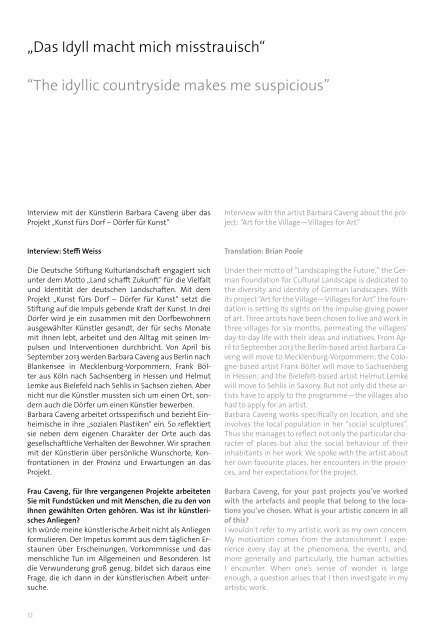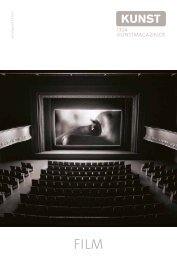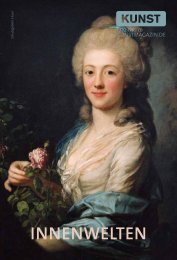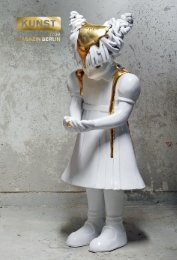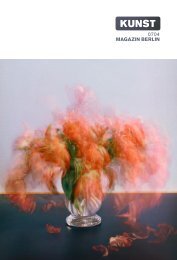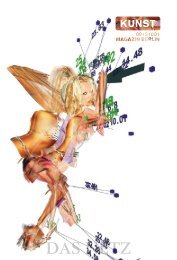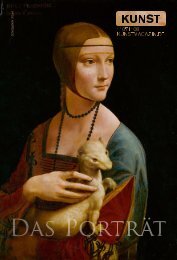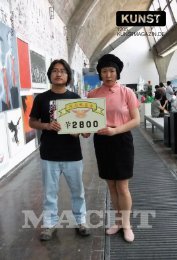Download als .pdf - KUNST Magazin
Download als .pdf - KUNST Magazin
Download als .pdf - KUNST Magazin
Erfolgreiche ePaper selbst erstellen
Machen Sie aus Ihren PDF Publikationen ein blätterbares Flipbook mit unserer einzigartigen Google optimierten e-Paper Software.
„Das Idyll macht mich misstrauisch“<br />
“The idyllic countryside makes me suspicious”<br />
Interview mit der Künstlerin Barbara Caveng über das<br />
Projekt „Kunst fürs Dorf – Dörfer für Kunst“<br />
Interview with the artist Barbara Caveng about the project:<br />
“Art for the Village—Villages for Art”<br />
Interview: Steffi Weiss<br />
Translation: Brian Poole<br />
Die Deutsche Stiftung Kulturlandschaft engagiert sich<br />
unter dem Motto „Land schafft Zukunft“ für die Vielfalt<br />
und Identität der deutschen Landschaften. Mit dem<br />
Projekt „Kunst fürs Dorf – Dörfer für Kunst“ setzt die<br />
Stiftung auf die Impuls gebende Kraft der Kunst. In drei<br />
Dörfer wird je ein zusammen mit den Dorfbewohnern<br />
ausgewählter Künstler gesandt, der für sechs Monate<br />
mit ihnen lebt, arbeitet und den Alltag mit seinen Impulsen<br />
und Interventionen durchbricht. Von April bis<br />
September 2013 werden Barbara Caveng aus Berlin nach<br />
Blankensee in Mecklenburg-Vorpommern, Frank Bölter<br />
aus Köln nach Sachsenberg in Hessen und Helmut<br />
Lemke aus Bielefeld nach Sehlis in Sachsen ziehen. Aber<br />
nicht nur die Künstler mussten sich um einen Ort, sondern<br />
auch die Dörfer um einen Künstler bewerben.<br />
Barbara Caveng arbeitet ortsspezifisch und bezieht Einheimische<br />
in ihre „sozialen Plastiken“ ein. So reflektiert<br />
sie neben dem eigenen Charakter der Orte auch das<br />
gesellschaftliche Verhalten der Bewohner. Wir sprachen<br />
mit der Künstlerin über persönliche Wunschorte, Konfrontationen<br />
in der Provinz und Erwartungen an das<br />
Projekt.<br />
Frau Caveng, für Ihre vergangenen Projekte arbeiteten<br />
Sie mit Fundstücken und mit Menschen, die zu den von<br />
Ihnen gewählten Orten gehören. Was ist ihr künstlerisches<br />
Anliegen?<br />
Ich würde meine künstlerische Arbeit nicht <strong>als</strong> Anliegen<br />
formulieren. Der Impetus kommt aus dem täglichen Erstaunen<br />
über Erscheinungen, Vorkommnisse und das<br />
menschliche Tun im Allgemeinen und Besonderen. Ist<br />
die Verwunderung groß genug, bildet sich daraus eine<br />
Frage, die ich dann in der künstlerischen Arbeit untersuche.<br />
Under their motto of “Landscaping the Future,” the German<br />
Foundation for Cultural Landscape is dedicated to<br />
the diversity and identity of German landscapes. With<br />
its project “Art for the Village—Villages for Art” the foundation<br />
is setting its sights on the impulse-giving power<br />
of art. Three artists have been chosen to live and work in<br />
three villages for six months, permeating the villagers’<br />
day-to-day life with their ideas and initiatives. From April<br />
to September 2013 the Berlin-based artist Barbara Caveng<br />
will move to Mecklenburg-Vorpommern; the Cologne-based<br />
artist Frank Bölter will move to Sachsenberg<br />
in Hessen; and the Bielefelt-based artist Helmut Lemke<br />
will move to Sehlis in Saxony. But not only did these artists<br />
have to apply to the programme—the villages <strong>als</strong>o<br />
had to apply for an artist.<br />
Barbara Caveng works specifically on location, and she<br />
involves the local population in her “social sculptures”.<br />
Thus she manages to reflect not only the particular character<br />
of places but <strong>als</strong>o the social behaviour of their<br />
inhabitants in her work. We spoke with the artist about<br />
her own favourite places, her encounters in the provinces,<br />
and her expectations for the project.<br />
Barbara Caveng, for your past projects you’ve worked<br />
with the artefacts and people that belong to the locations<br />
you’ve chosen. What is your artistic concern in all<br />
of this?<br />
I wouldn’t refer to my artistic work as my own concern.<br />
My motivation comes from the astonishment I experience<br />
every day at the phenomena, the events, and,<br />
more generally and particularly, the human activities<br />
I encounter. When one’s sense of wonder is large<br />
enough, a question arises that I then investigate in my<br />
artistic work.<br />
Blankensee fotografiert von Olaf Lesener<br />
Auf welche Fragen sind Sie bisher gestoßen?<br />
Im Jahr 2003 realisierte ich mein erstes partizipatives<br />
Kunstprojekt mit dem Titel „Ready Now“. Auslöser war<br />
ein Foto im Tagesspiegel, unmittelbar vor dem Ausbruch<br />
des Irakkrieges. Die Luftaufnahme zeigt die fünfhundert<br />
Mann starke Besatzung des amerikanischen Flugzeugträgers<br />
Abraham Lincoln auf Deck. Die Soldaten<br />
bilden den Schriftzug „Ready Now“ mit ihren Körpern.<br />
Das war für mich eine große Frage, der ich ein Jahr gewidmet<br />
habe: Was heißt „Ready Now“? Fertig – wofür?<br />
Es war die Zeit, <strong>als</strong> der damalige US-Präsident George<br />
W. Bush mit der Formulierung von der „Achse des Bösen“<br />
die Welt gespalten hat. Die zweite Frage, die ich<br />
mir stellte, war: Was bedeutet kulturelle Identität? Aus<br />
diesen beiden Fragen entstand über einen Zeitraum von<br />
sechs Monaten ein elf Quadratmeter großer Teppich<br />
mit 330.000 Knoten, der von über 250 Menschen aus 55<br />
Nationen geknüpft wurde. Teil der Installation ist eine<br />
Soundbibliothek der Gespräche, die die Teilnehmer zu<br />
dieser Frage führten. Identität und Zugehörigkeit sind<br />
Themen, die in unterschiedlichen Aspekten immer wieder<br />
in meinen Arbeiten auftauchen. So zum Beispiel in<br />
der Trilogie der „Sozialen Bodenbeläge“. Die Frage, wer<br />
sich in welcher Form <strong>als</strong> Teil der Gesellschaft versteht,<br />
wurde durch die ausufernden Formationen von ausrangierten<br />
Möbelstücken im öffentlichen Raum ausgelöst.<br />
What questions have you already encountered?<br />
In 2003 I completed my first participatory art project,<br />
entitled “Ready Now”. It was inspired by a photo in the<br />
newspaper Tagespiegel that appeared just before the<br />
beginning of the war in Iraq. The aerial photo showed<br />
the five-hundred-member crew of the aircraft carrier<br />
Abraham Lincoln standing on the deck. The soldiers<br />
formed the words “Ready Now” with their bodies. This<br />
raised a large question that preoccupied me for one<br />
year: What does “Ready Now” mean? Ready for what?<br />
This was a time when the then acting American president<br />
George W. Bush had divided up the world with his<br />
notion of the “axis of evil”. The second question I asked<br />
myself was: What does cultural identity mean? Based<br />
on these questions, over a period of six months an 11<br />
cubic metre carpet was assembled containing 330,000<br />
stitches linked together by more than 250 people from<br />
55 different nations. Part of the installation is a sound<br />
library with recordings of the conversations the participants<br />
had on this subject. Identity and ‘belonging’ are<br />
topics that reoccur in my work in various ways—for example,<br />
in the trilogy “Social Floor Surfaces”. The question<br />
who considers themselves a part of society, and in<br />
what form was triggered by the sprawling accumulation<br />
of discarded pieces of furniture in public space.<br />
12<br />
13


